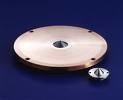4.2.3. Mass Analyzer Interface
Sample cations enter into the mass filter from the plasma through a series of nickel or platinum cones that contain a small hole (from 1.0 mm to less than 0.1 mm) in the center. These cones are necessary to achieve the pressure drop that is required for the mass analyzer. The low pressure of the system, 10-5 torr, minimizes the collision of the chemically reactive analyte cations with ambient gases. A photograph of a cone is shown in Figure 4-2. Cones are one of the most maintenance intensive components of an ICP-MS since they require frequent cleaning, but the cleaning process is easy and relatively fast. After cleaning, cones must be conditioned prior to use by exposing the clean cones to a mid- to high-range reference standard via the plasma for 20 to 30 minutes. This conditioning process will avoid analyte loss on the cone and memory effects (the persistent present of an analyte in a blank run typically occurring after a high concentration standard or sample has been analyzed).

Figure 4-2. Photograph of a Skimmer and Sampler Cone for ICP-MS. Reprinted with permission from Agilent Technologies, Inc.
The low pressure in the spectrometer chamber is maintained with two vacuum pumps. First, an external rotary vacuum pump is used to remove gas molecules down to a pressure of 10-1 to 10-4 torr; a rotary vacuum pump is a positive-displacement pump that consists of vanes mounted to a spinning rotor. After a sufficient vacuum has been reached, a turbo molecular pump takes the vacuum down to 10-5 to 10-6 torr. A molecular pump operates by using high speed rotating blades to literally knock gaseous molecules out of the chamber. The low vacuum pressures are needed to minimize secondary collisions between analyte cations and ambient atmospheric molecules that deflect the cations path away from the mass filter and detector and interfere with the desired trajectory in the mass filter.
| Frank's Homepage |
©Dunnivant & Ginsbach, 2008